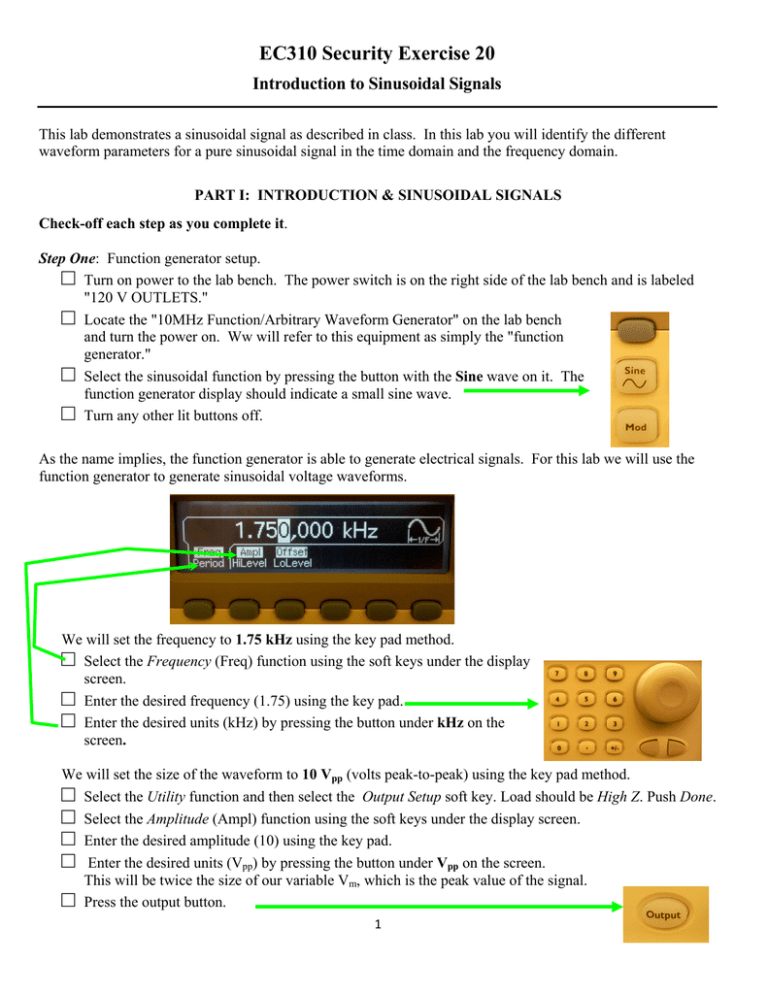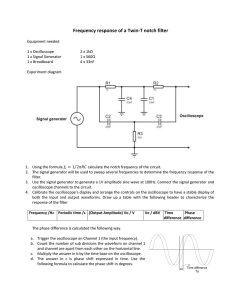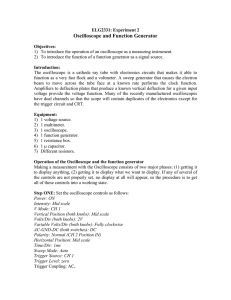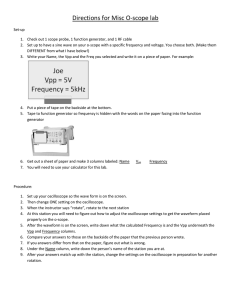EC310 SE20
advertisement

EC310 Security Exercise 20 Introduction to Sinusoidal Signals This lab demonstrates a sinusoidal signal as described in class. In this lab you will identify the different waveform parameters for a pure sinusoidal signal in the time domain and the frequency domain. PART I: INTRODUCTION & SINUSOIDAL SIGNALS Check-off each step as you complete it. Step One: Function generator setup. □ Turn on power to the lab bench. The power switch is on the right side of the lab bench and is labeled "120 V OUTLETS." □ Locate the "10MHz Function/Arbitrary Waveform Generator" on the lab bench and turn the power on. Ww will refer to this equipment as simply the "function generator." □ Select the sinusoidal function by pressing the button with the Sine wave on it. The function generator display should indicate a small sine wave. □ Turn any other lit buttons off. As the name implies, the function generator is able to generate electrical signals. For this lab we will use the function generator to generate sinusoidal voltage waveforms. We will set the frequency to 1.75 kHz using the key pad method. □ Select the Frequency (Freq) function using the soft keys under the display screen. □ Enter the desired frequency (1.75) using the key pad. □ Enter the desired units (kHz) by pressing the button under kHz on the screen. We will set the size of the waveform to 10 Vpp (volts peak-to-peak) using the key pad method. □ Select the Utility function and then select the Output Setup soft key. Load should be High Z. Push Done. □ Select the Amplitude (Ampl) function using the soft keys under the display screen. □ Enter the desired amplitude (10) using the key pad. □ Enter the desired units (Vpp) by pressing the button under Vpp on the screen. This will be twice the size of our variable Vm, which is the peak value of the signal. □ Press the output button. 1 Right now your function generator is generating a 1.75 kHz signal that has a peak-to-peak voltage of 10V. But…that signal is not leaving the function generator. To see the signal, we will send the output of the function generator to an oscilloscope. Proceed to Step Two! Step Two: Oscilloscope familiarization. □ Locate the oscilloscope at the top of your lab bench and turn its power on. The power push button is located on the top left of the oscilloscope. The oscilloscope can receive electrical signals from two probes, channel 1 (CH 1) and channel 2 (CH 2). We have attached adaptors to CH 1 and CH 2, so that they can receive electrical signals via our banana plug cables. □ □ Locate the CH 1 input on your oscilloscope. It will have a two-input (RED / BLACK) banana plug adaptor installed. Connect banana plug cables (which can be found under the bench on the plastic Quad board) from the function generator’s output to the CH 1 input on the oscilloscope (red to red and black to black). The oscilloscope has the ability to measure and display two different electrical signals, but only with respect to one common reference point. The BLACK CH 1 input provides this common reference point for CH 1 and CH 2. Therefore, CH2 has an adaptor for only one banana plug. We will not be using CH2 for this lab. Before looking at our sine wave on the scope in detail, let's first pause and look at a generic display which explains how the information on the oscilloscope screen is presented. Your screen will not look like the screen shown in Figure 1 below! In Fig 1, we see that the oscilloscope display is divided up into eight major vertical divisions. The bottom left corner of the oscilloscope—where you see "CH1 100mV"—indicates the number of volts per division for a given channel. You can see that CH 1 and CH 2 indicate 100mV per division, therefore each major division in the vertical axis represents 100mV. Figure 1 Major division 100 mV per vertical division 250 μsec per horizontal division 2 Similarly there are ten major divisions on the horizontal axis that represent time. Each major division on the horizontal axis of Fig. 1 represents 250μs. CH1 and CH 2 can have different Volts/Div, but will always share the same Sec/Div. Step Three: Display your sine wave with the oscilloscope. □ Press the AUTOSET button( top right) on the oscilloscope. AUTOSET will measure the input signals for the channels selected and attempt to display something meaningful. □ □ □ □ □ With the CH 1 menu selected, adjust the position of the vertical axis zero level by rotating the position knob under the vertical section in the CH 1 column, so that the “1→” on the left side of the LCD is adjacent to the major horizontal axis (centered vertically on the display). Press the CH2 Menu button twice to turn off the CH 2 trace, since nothing is connected to CH 2 for this lab. Press CH 1 MENU on the oscilloscope and make the following settings. Coupling: AC BW Limit: OFF Volts/Div: COARSE Probe: 1X Invert: Off Adjust the VOLTS/DIV knob under the vertical section in the CH 1 column, so that CH 1 indicates 2 Volts/Div on the bottom left corner of your display. Adjust the SEC/DIV knob under the horizontal axis, so that the oscilloscope indicates 100 µs per major division on the LCD on the bottom middle of your display. Step Four: Measuring the waveform on the oscilloscope. Manual method. The first method is by counting the divisions of grid and applying the scale (volts/div for vertical, or sec/div for horizontal). This will only provide you with approximate values with little precision. 3 Question 1. Fill out the table on your answer sheet using this manual measurements method. Specifically: □ Using the vertical scale, determine the peak-to-peak voltage of CH1 (which is the voltage from the Function Generator signal source) which is the total voltage from positive peak to the negative peak. That is, you should count the number of vertical divisions from peak to peak, and multiply the number of divisions by the number of volts/division. □ Determine the amplitude of the signal. □ Using the horizontal scale, determine the period (T) and then calculate the signal's frequency. That is, you should count the number of horizontal divisions for one full cycle, and then multiply the number of divisions by the number of microseconds (in this case) per division. Taking automatic measurements. The oscilloscope has the ability to take automated measurements of voltage, period and frequency. □ Press the Measure button (top middle) to view the measurement menu on LCD, then push the top menu box button to highlight Source and select CH1 for Measure 1. □ Then choose the Type of measurement to be Pk-Pk by cycling through the options on the button associated with this menu option, and then hit button for Back option □ Press the second to top menu box button to select Measure 2. □ Then choose the Type of measurement to be Freq by cycling through the options on the button associated with this menu option, and then hit button for Back option □ You can add new measurements for all 5 buttons. Amplitude is not automatically measured but can still be calculated from the peak-to-peak voltage as before. Record your results in Question 2. Question 2. Fill out the table on your answer sheet using automatic measurements method. Consider how you would describe your sinusoidal signal as an= equation: v(t ) Vm sin [ (2π f t ) + θ ] [volts] The phase describes the start of one signal relative to another, so we will assume the phase is zero. Question 3. Enter the results from your measurements from the previous pages into the equation: v(t) =________________________________ ( Show values) Write your answer to Question 3 on your answer sheet. Step Five: Measuring a pure sine wave in the frequency domain. Our scope can also provide a frequency spectrum of a signal. For this particular sinusoidal signal we know it is periodic and has a single frequency, f, described by the previous measurements and shown in our equation. Now let us try to understand how this signal is displayed in the frequency domain. The oscilloscope performs a Fast Fourier Transform (FFT) and displays the magnitudes of the frequencies present in the signal vs. frequency, so the horizontal scale shows frequency instead of time. □ Press AUTOSET (top right) and you will see the options to display the signal in time or in frequency (FFT). 4 □ □ Push the button next to the FFT and you will see a spike at a particular frequency. Set the horizontal scale to read 250Hz per division. Question 4. Determine the value of the frequency component ( f = _______) by counting the number of horizontal divisions and multiplying that by the number of Hz per division. Question 5. Sketch your frequency plot and label the axes with your values have your instructor check it. PART II: PUTTING YOU TO THE TEST! So…are you comfortable using the function generator and the oscilloscope? Let's find out! Your instructors have pre-set two different sinusoidal signals into the function generator. Your goal is to determine the amplitude and frequency of each. □ □ □ Reset the Oscilloscope back to the time domain from the frequency domain, by pressing the Autoset button and then selecting the button next to the multiple cycles of a sinewave (at the top, above the FFT button). (If the pesky Channel 2 display is active, hit CH2 Menu twice.) Yell loudly in a high pitch to get your Instructor/Lab Tech's attention. Your Instructor/Lab Tech will enter Challenge Signal 1. You will find this challenging because it is named "Challenge Signal 1." Push AUTOSET on the Oscilloscope. Determine the amplitude and frequency of the sine wave. Obviously you should use only the oscilloscope (do not try to finagle with the function generator, pushing various buttons to see if it will cough up the answer!) Use only the oscilloscope! Place your answers in Question 6. Show your instructor or lab tech before continuing. □ □ Yell loudly in a low rumbly voice to get your Instructor/Lab Tech's attention. Your Instructor/Lab Tech will enter Challenge Signal 2. You will find this challenging because…well…you know. Push AUTOSET on the Oscilloscope. Determine the amplitude and frequency of the sine wave. Use only the oscilloscope! Place your answers in Question 7. Show your instructor or lab tech before calling it a day. My monument is “16 minutes from Home”. Who am I? For Extra Credit: Where is my monument? PART III: IT'S A WRAP! □ □ □ □ Unplug and stow the banana plug cables. Turn off your oscilloscope. Turn off your function generator. Pat yourself on the back for your cyber expertise. 5 EC310 Security Exercise 20 Name: __________________________________________________________________________________________ Question 1: Peak-to-peak(Vpp) Amplitude(V) Period (µs) Frequency (kHz) Peak-to-peak(Vpp) Amplitude(V) Period (µs) Frequency (kHz) V(t) (CH1) Question 2: V(t) (CH1) Question 3: Question 4: Question 5: __________________________________ Instructor / Lab Tech Question 6: Question 7: Amplitude: __________ Frequency: __________ Amplitude: __________ Frequency: __________ ___________________ Instructor / Lab Tech ____________________ Instructor / Lab Tech 6







